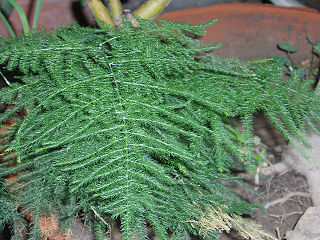
Asparagus is a genus of flowering plants in the family Asparagaceae, subfamily Asparagoideae. It comprises up to 300 species. Most are evergreen long-lived perennial plants growing from the understory as lianas, bushes or climbing plants. The best-known species is the edible Asparagus officinalis, commonly referred to as just asparagus. Some other members of the genus, such as Asparagus densiflorus, are grown as ornamental plants.

Protopterus is the genus of four species of lungfish found in Africa. Protopterus is considered the sole genus in the family Protopteridae, which is sometimes grouped with Lepidosiren in the family Lepidosirenidae.
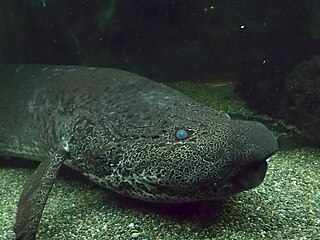
The marbled lungfish is a lungfish of the family Protopteridae. Also known as the leopard lungfish, it is found in Eastern and Central Africa, as well as the Nile region. At 133 billion base pairs, it has the largest known genome of any vertebrate and one of the largest of any organism, along with Polychaos dubium and Paris japonica at 670 billion and 150 billion, respectively.

Kentrosaurus is a genus of stegosaurid dinosaur from the Late Jurassic in Lindi Region of Tanzania. The type species is K. aethiopicus, named and described by German palaeontologist Edwin Hennig in 1915. Often thought to be a "primitive" member of the Stegosauria, several recent cladistic analyses find it as more derived than many other stegosaurs, and a close relative of Stegosaurus from the North American Morrison Formation within the Stegosauridae.

The African sacred ibis is a species of ibis, a wading bird of the family Threskiornithidae. It is native to much of Africa, as well as small parts of Iraq, Iran and Kuwait. It is especially known for its role in Ancient Egyptian religion, where it was linked to the god Thoth. The species is currently extirpated from Egypt.

Paranthropus aethiopicus is an extinct species of robust australopithecine from the Late Pliocene to Early Pleistocene of East Africa about 2.7–2.3 million years ago. However, it is much debated whether or not Paranthropus is an invalid grouping and is synonymous with Australopithecus, so the species is also often classified as Australopithecus aethiopicus. Whatever the case, it is considered to have been the ancestor of the much more robust P. boisei. It is debated if P. aethiopicus should be subsumed under P. boisei, and the terms P. boisei sensu lato and P. boisei sensu stricto can be used to respectively include and exclude P. aethiopicus from P. boisei.

A sagittal crest is a ridge of bone running lengthwise along the midline of the top of the skull of many mammalian and reptilian skulls, among others. The presence of this ridge of bone indicates that there are exceptionally strong jaw muscles. The sagittal crest serves primarily for attachment of the temporalis muscle, which is one of the main chewing muscles. Development of the sagittal crest is thought to be connected to the development of this muscle. A sagittal crest usually develops during the juvenile stage of an animal in conjunction with the growth of the temporalis muscle, as a result of convergence and gradual heightening of the temporal lines.
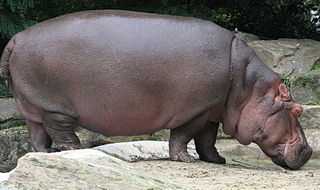
Hippopotamus is a genus of artiodactyl mammals consisting of one extant species, Hippopotamus amphibius, the river hippopotamus, and several extinct species from both recent and prehistoric times. It belongs to the family Hippopotamidae, which also includes the pygmy hippopotamus and a number of extinct genera.
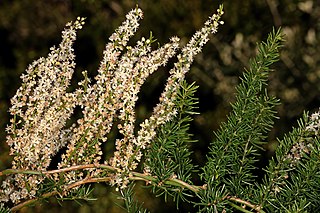
Asparagus aethiopicus, Sprenger's asparagus, is a plant native to the Cape Provinces and the Northern Provinces of South Africa. Often used as an ornamental plant, it is considered an invasive weed in many locations. Asparagus fern, asparagus grass and foxtail fern are common names; however, it is unrelated to true ferns. A. aethiopicus has been confused with A. densiflorus, now regarded as a separate species, so that information about A. aethiopicus will often be found under the name A. densiflorus.
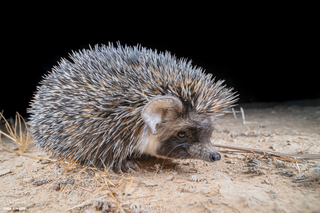
The desert hedgehog is a species of mammal in the family Erinaceidae.

The desert warthog is a species of even-toed ungulate in the pig family (Suidae), found in northern Kenya and Somalia, and possibly Djibouti, Eritrea, and Ethiopia. This is the range of the extant subspecies, commonly known as the Somali warthog. Another subspecies, commonly known as the Cape warthog, became extinct around 1865, but formerly occurred in South Africa.

Phacochoerus is a genus in the family Suidae, commonly known as warthogs. They are pigs who live in open and semi-open habitats, even in quite arid regions, in sub-Saharan Africa. The two species were formerly considered conspecific under the scientific name Phacochoerus aethiopicus, but today this is limited to the desert warthog, while the best-known and most widespread species, the common warthog, is Phacochoerus africanus.
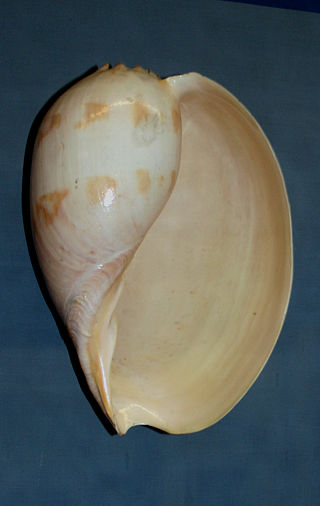
Melo aethiopicus, common name the crowned baler, is a very large sea snail, a marine gastropod mollusc in the family Volutidae, the volutes.
Raapenberg Bird Sanctuary is a 10-hectare (25-acre) protected area in Cape Town, located on the Liesbeek river near the suburb of Observatory.
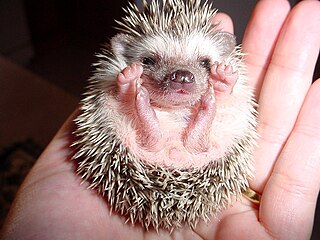
Paraechinus is a genus of hedgehogs. Members are small and nocturnal. The genus contains four species from North Africa, the Middle East and South Asia:

Asparagus densiflorus, the asparagus fern, plume asparagus or foxtail fern, is a variable evergreen perennial plant, closely related to the vegetable asparagus.
Achrysonini is a tribe of beetles in the subfamily Cerambycinae, mainly found in Africa, Asia, and Southern Europe.
Copelatus aethiopicus is a species of diving beetle. It is part of the genus Copelatus in the subfamily Copelatinae of the family Dytiscidae. It was described by Régimbart in 1906.
Afreumenes aethiopicus is a species of wasp in the family Vespidae. It was described by Saussure in 1852.
Allogaster is a genus of beetles in the longhorn beetle family. Its first appearance was believed to be around 125.45 million years ago. They are mainly found in sub-Saharan Africa.













